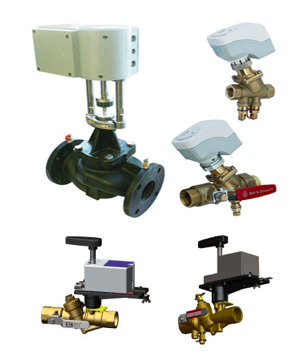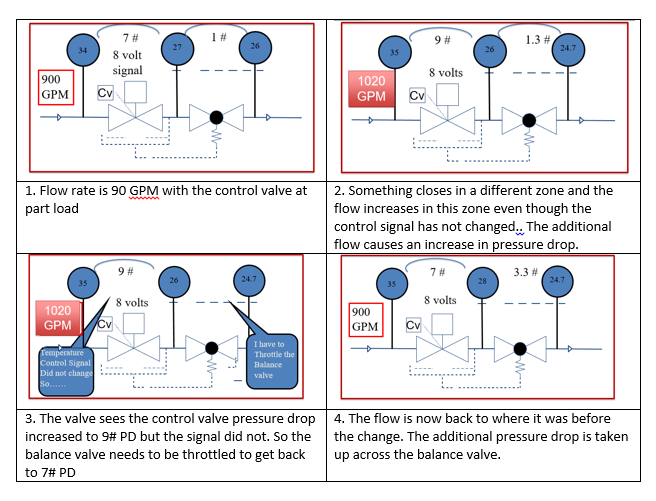
Image courtesy of: http://griswoldcontrols.com/pressure-independent-control-valves/ & http://bellgossett.com/flow-balancing/ultra-setter-pressure-independent-control-valve/
Air side terminal units have used pressure independent control valves for a long time. These valves, also called PICV, are still relatively new in hydronics. These devices combine the traditional temperature control valve with an automatic or pressure limiting balance valve. Two required activities in one body.
Why Use a Pressure Independent Control Valve?
Last week, the R. L. Deppmann Monday Morning Minutes reviewed the value of an automatic flow limiting balance valve in variable flow systems with diversity. These automatic balance valves prevent gigantic misses in the required flow rate in variable speed systems. They also provide flow limiting advantage in systems where hydraulic changes will cause energy wasting overflow in zones.
The problem is that the flow limiting advantage only occurs at the design flow rate, when the control valve is fully open. What can we do when a reduced flow rate is required at the terminal unit? That is where the pressure independent control valve (PICV) will really help.
The PICV will limit the flow rate by readjusting the flow limiting portion of the valve each time the control signal changes. It combines the advantage of avoiding large misses in variable speed systems, reducing energy losses at design flow rates due to hydraulic changes, AND reduces those energy losses at partial flow as well.
How Does a Pressure Independent Control Valve (PICV) Work?
Let’s look at a short video from Chris Lieder at R. L. Deppmann. He created the video to show how the PICV works.
The internal operation of these valves varies with each manufacturer. A simple way to think about them is to imagine the automatic flow limiting balance GPM gets changed to a new fixed flow rate every time the control valve changes position.

Contract Issues and Combining More Devices
When we start combining control devices and balance devices together, it may reduce the overall cost, but it may cause an issue in the project contracts. Traditionally, the control contractor purchases the control valve and actuator and provides them to the mechanical contractor to install. Traditionally, the mechanical contractor purchases and installs the balancing valve.
These PICVs can also have additional devices added which will reduce the overall piping cost to your client. You can choose to add strainers, pressure-temperature ports (something for a balance contractor to read), shutoff valves, manual air vents, and unions.
The important thing is to indicate both the temperature control and piping details, who is providing the valves, who is installing them, and who is wiring them.
Griswold and Bell & Gossett Pressure Independent Control Valves
Both of these manufacturers have great proven products. We are often asked about the key differences. There are many differences, but two that stand out for your consideration are:
- The smaller Griswold valves have a universal mounting plate option that allows you to install a large variety of actuator brands on the product. Bell & Gossett (B&G) has several choices of actuators but will not adapt to as many brands.
- The smaller B&G valves have a design that allows for the full stroke of the control valve even in a balanced position and they have models with a dial so the flow rate can be changed without changing the cartridge.
Contact us if you want to review specifications and options available to you.
Next week, the R L. Deppmann Monday Morning Minutes will conclude this series by showing the need for a balance contractor with all of these balancing methods.
Discover more on this Series: Balancing HVAC Hydronic Systems:
Balancing HVAC Hydronic Systems: Flow Tolerance (Part 1)
Balancing HVAC Hydronic Systems: Control Valves vs. Balance Valves (Part 2)
Balancing HVAC Hydronic Systems: Flow Measurement Valves (Part 3)
Balancing HVAC Hydronic Systems: Automatic Flow Limiting (Part 4)

